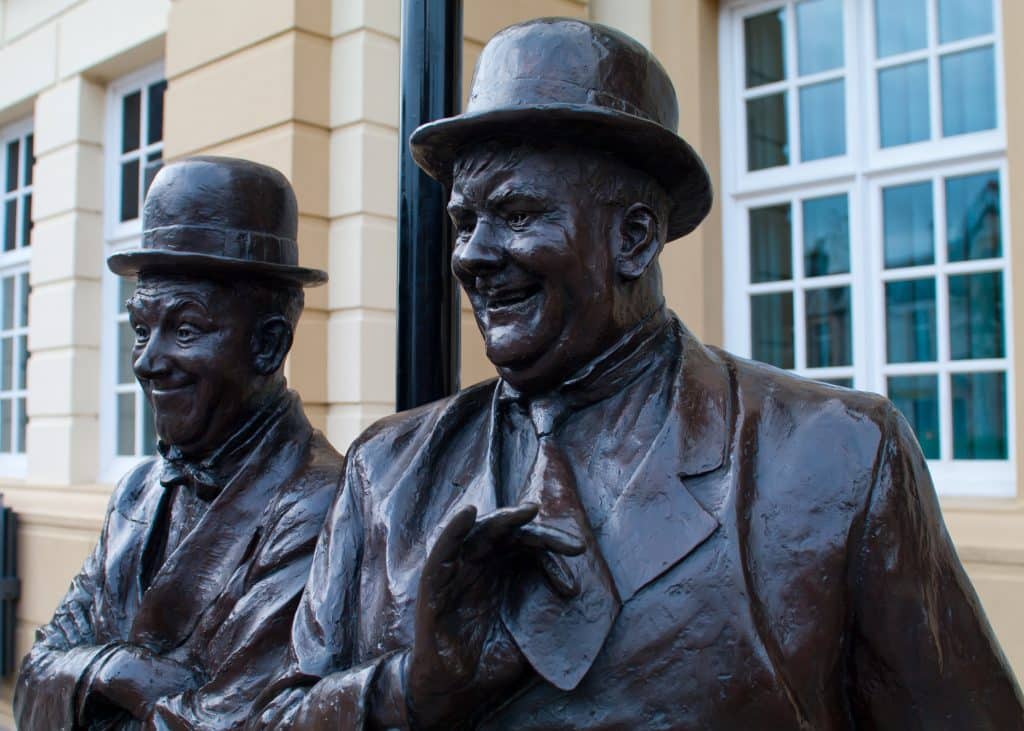Some actors, musicians and creative people enjoy a brief period of success and instant wealth only to fall on hard times later. Some, like Mozart, were successful for the whole duration of their lives but, due to poor financial management, constantly found themselves writing to creditors, in need of cash. A more recent – but still historic – example comes from the early days of cinema, and allows us to compare the different fates of people who enjoyed similar levels of fame.

Charles Chaplin (1889-1977) and the comedy duo Laurel and Hardy (Stan Laurel, 1890-1965; Oliver Hardy 1892-1957) were all global household names 95 years ago, but only Chaplin would die a millionaire. Below is a look at their careers, their similarities and differences and a potential explanation for why their careers ended quite differently.
Chaplin was born in London and was raised in a single-parent household as his father left the family before his first birthday. With Chaplin’s mother suffering from poor mental health, she was admitted to an asylum – which meant that the seven-year-old Charles and his brother had to stay at the local workhouse, and briefly with his alcoholic father whom he had no previous contact with. Hannah Chaplin’s ability to imitate people and make others laugh had given her a career as a music hall actor, and luckily her skills were passed on to her son, who entered the same line of work. After emigrating to America, where he continued to work as a Vaudeville actor, Chaplin began to appear in silent movies in 1914. Initially, he disapproved of the exaggerated acting style that soundless movies required, but reached global fame by the end of World War I.
Why Chaplin became the first – or at least one of the first – world celebrities is open to speculation. What is certain is that his tramp character had a universal appeal as the eternal underdog but, despite his poverty, the viewer is rarely made to feel sorry for the tramp. In fact, the tramp is a man of action who usually defeats his enemies and gets his sweetheart at the end of the film. Further, with a few exceptions, most of the films were not set in America-specific locations but were relatable for viewers across the industrialized world. When Chaplin was not offered a pay increase, he left Keystone Studios and signed a contract with the Essaney Film Manufacturing Company. A year later he began working with the Mutual Film Corporation and, at age 26, was the highest paid man in the world. Unhappy with the large production companies’ lack of concern over quality – and the funding they were prepared to allocate to his films – Chaplin set up his own production and distribution company, United Artists, together with three other actors in 1919. This gave the actors complete control over their movies and was unprecedented at the time.
Chaplin continued to direct and appear in films throughout the 1920s. He was reluctant to produce ‘talkies’ at first as he feared he would lose his universal appeal if he was heard speaking English. Nonetheless, he eventually branched out in 1940 with The Great Dictator, followed by other, less known films such as Limelight (1952) and A King in New York (1954). Following accusations of being a Communist supporter – generally seen as incorrect by now – Chaplin was unable to return to America and settled in Switzerland, where he lived until his death in 1977. Charlie Chaplin’s estate was estimated to be worth $100 million, or $400 million in today’s value. To a large extent, this is likely due to his decision to found United Artists in 1919 – which meant that managers and producers got a relatively small cut of the box office revenue.

For Laurel and Hardy, the story was different. Both were born into stage-performing families just like Chaplin but had more stable childhoods. Stan Laurel was born in Lancashire and grew up in Glasgow, where his father was a theatre manager. It was here that he made his stage debut and, as a travelling performer, he eventually chose to emigrate to America just like Chaplin. In the 1920s, Laurel began working with American comedian Oliver Hardy and they quickly became one of the most recognizable comedy duos. The skinny, timid and careful character of Laurel stood in sharp contrast to the stout, overconfident bully played by Hardy. Unlike Chaplin, most of their career was after the introduction of ‘talkies’ in the 1930s.
Few silent comedy actors survived the introduction of sound film, so the fact that Laurel and Hardy did shows their adaptability and versatility. Appearing in over 100 films – of which 23 were feature-length movies – the duo was successful by any definition. Nonetheless, when their career was over by the 1950s, both actors fell on hard times. Oliver Hardy passed away with an estate worth $500,000 in 1957 – which was a considerable sum at the time, but not reflective of his fame and success. Estimates of Stan Laurel’s estate vary, but it is generally believed that his net worth was a five-digit amount by the time he died in 1965.
Laurel and Hardy themselves attribute their relative lack of wealth to producers, agents and others who took a considerable cut. Contrarily to Chaplin, they had never set up their own production company and did generally not receive very good contracts – as was common at the time. Notably, they did not receive any royalties from the many copies of their silent films which were released for home viewing in the 1950s. Leading his own distribution company – and having acquired the rights to his earliest films – Chaplin was, conversely, able to generate a steady income from this new market.
Overall, then, it seems that acting and comedic talent – not even world fame – do not guarantee a wealthy life. Unless it is combined with business skills – as demonstrated by Chaplin.
